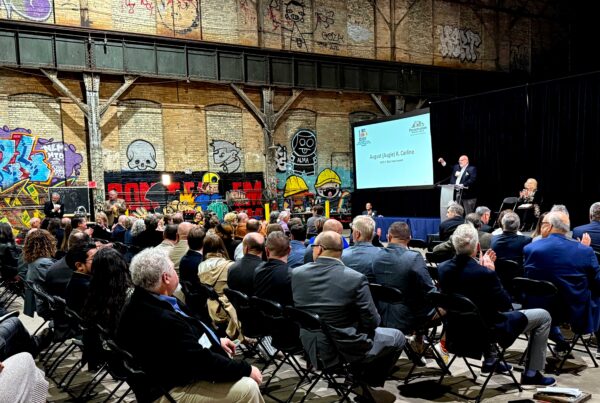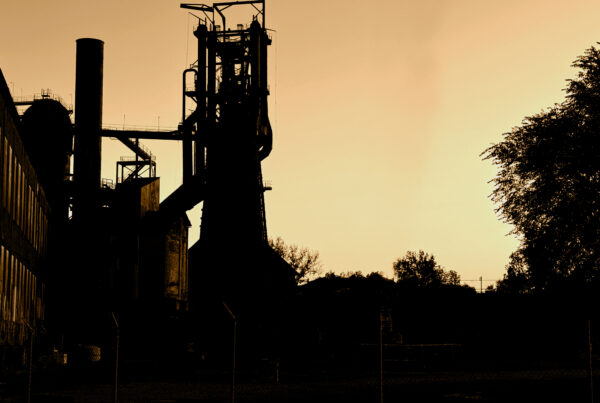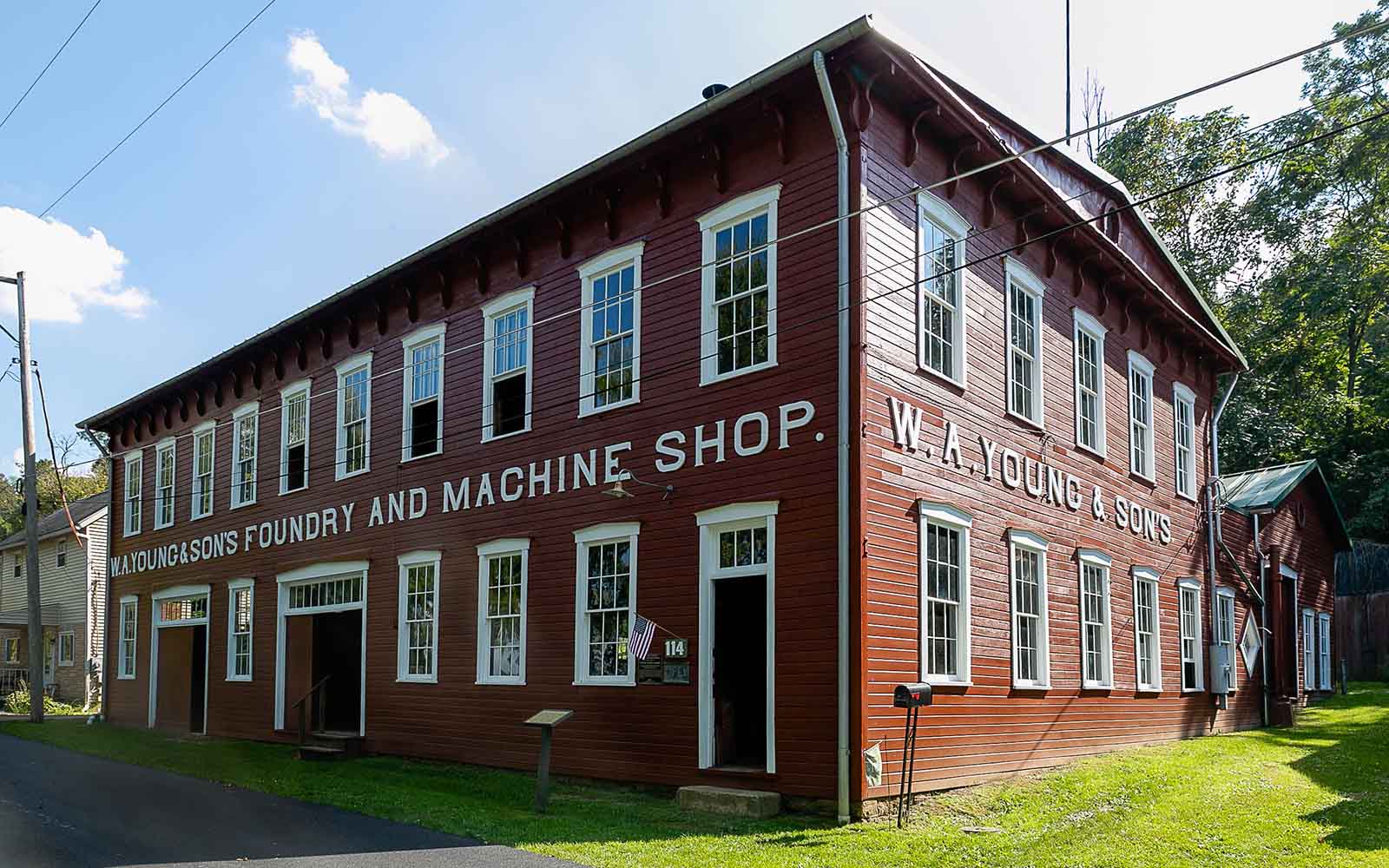
By Carly V. McCoy, Director of Communications | Image: W.A. Young & Sons Foundry and Machine Shop in Rices Landing, PA. Photo by Richard Kelly Photography.
The Restoration of the W.A. Young & Sons Foundry and Machine Shop
If you haven’t yet had the chance to tour the W.A. Young & Sons Foundry and Machine Shop, your window of opportunity is closing, for now at least; just a few tours remain on the schedule before it’s shuttered for the season. However, visitors to this National Historic Landmark in the coming weeks will get to see the structure as few have—with a completely restored exterior!
The recently completed work reflects a five-phase, ten-year process to painstakingly repair this historic workshop, an investment of nearly $1.5 million. Coincidently, it was built in several phases, too. In 1900, William A. Young, a farmer trained in carpentry, acquired a plot of land along Water Street in Rices Landing, Greene County. The following year, his mother acquired the adjacent plot that she sold to him at cost. It was here that Young constructed the workshop, which would become his life’s work—and ultimately the life’s work of his two sons, Walter and Carl.
A Hand-Built Workshop & Small Job Shop

The forge and blacksmithing station in the back shop of Young and Sons. Image by Richard Kelly Photography.
The core of the building is a two-story wooden structure that houses the machine shop on the first floor and the pattern shop on an upper level. Next, a, U-shaped “back shop” with an earthen floor was added to house the blacksmithing area. (Interestingly, the floor is considered a safety feature, as sparks could ignite wooden floorboards.) The gap in the center of the addition had walls lined with windows, creating a light well for the workers. Finally, a vaulted foundry, complete with a cupola and an overhead crane, was added along the side of the expanded structure in 1908.
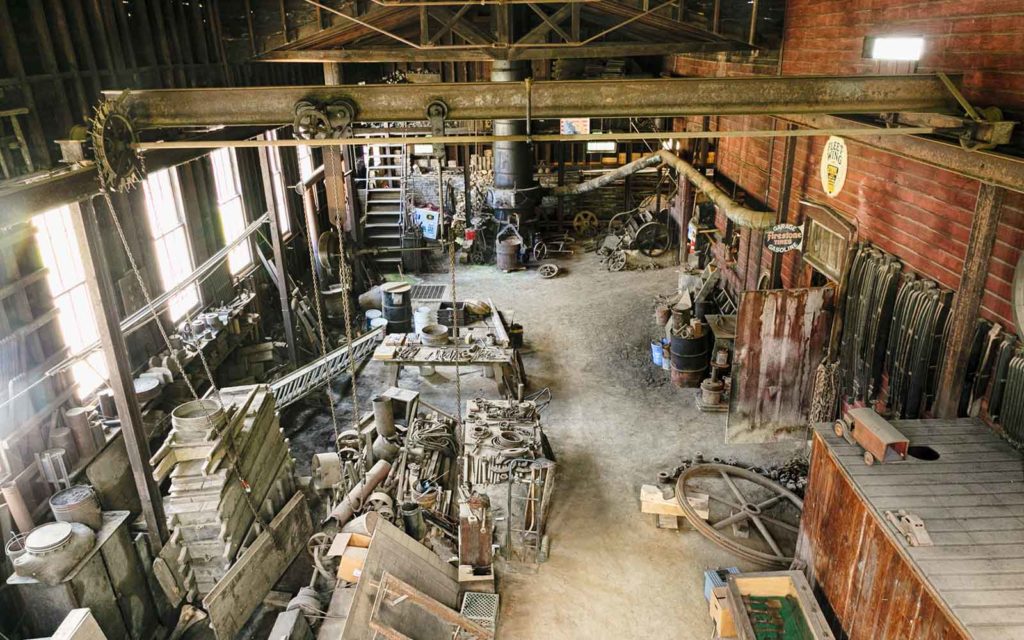
In this image of the foundry addition taken from the catwalk you can see the furnace in the back and the crane system above. Image by Richard Kelly Photography.
While the assemblage of this hand-built workshop is novel, it’s the work that occurred in the shop that makes it truly unique. W.A. Young’s business was classified as a “small job” shop. While the facility held 25 line shaft driven machines for fabricating industrial materials, in addition to the blacksmith shop and foundry, Young’s staff remained small, often just himself and a helper (later, his sons), and his client base was varied. They serviced a variety of industries, from steamboats and coal mines to residential needs and early auto repair.
A One-of-a-Kind, Historic Site
For most of the 1700s and 1800s, traditional blacksmith shops served their communities and aided industry, and by the 1900s most shops began to scale up, specializing for a specific industry. The W.A. Young & Sons Foundry and Machine Shop represents a transition between these two systems, which is one reason why it is so unique. The second, highly important, consideration is that the Machine Shop did not evolve with the times. Despite operating commercially though 1965, the Machine Shop remains today, more or less, just as Mr. Young built it more than a century ago, using technology from the 1880s and 1890s. (One exception is how the line shaft system was powered; originally, it used steam, then it used a Bessemer gas engine before converting to Westinghouse electric. A repurposed John Deere engine powers it today.)
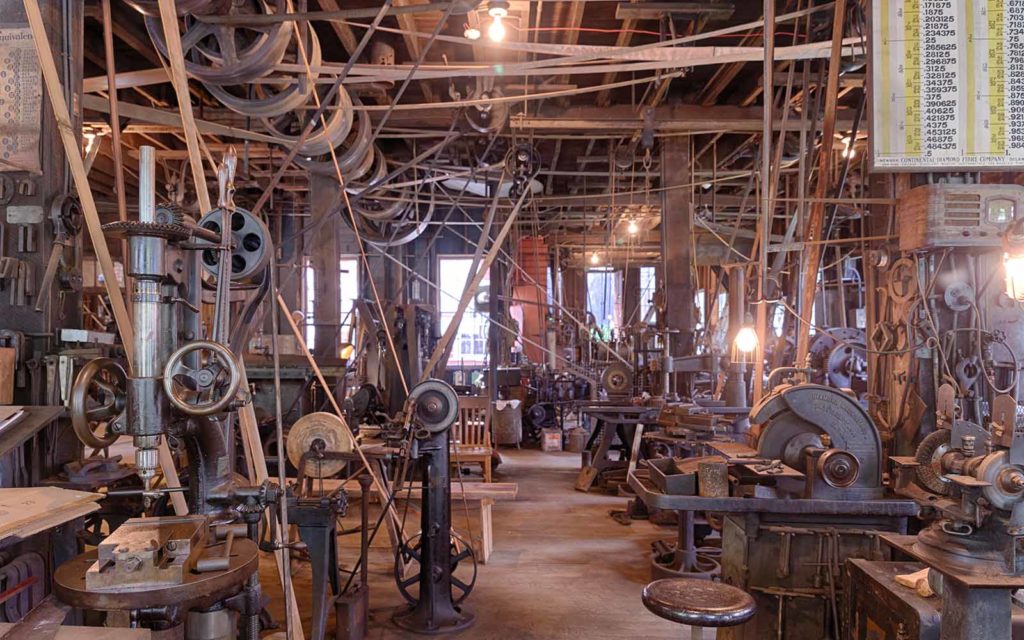
The interior of the front shop, featuring the machines and the line shaft system. Image by Richard Kelly Photography.
In a recent article in the Observer-Reporter about the Machine Shop’s restoration, Rivers of Steel’s CEO Augie Carlino reflected on the building’s role in understanding our region’s—and our nation’s—industrial history.
“First and foremost, the building and its history are critical to Rices Landing and Greene County as it represents the history and heritage of the people in that part of the Mon Valley,” he said. “Beyond Greene County, however, the Machine Shop is an industrial resource unique in the United States. The National Park Service has documented this fact. All similar machine shops from that era of operation are gone and no longer exist. So, the Machine Shop is that rare, one-of-a-kind, historic site that cannot be found anywhere. That alone is why it was important to save.
“But then, when you connect the dots of industrial history in the valley and Southwestern Pennsylvania, you begin to see how a small, family-run facility like the Machine Shop played a critical role in the industrial power of Pittsburgh and Southwestern Pennsylvania,” he continued. “The Machine Shop helps link the story of the steel mills, the coal mines, the river barges, and the railroads by illustrating how these small shops serviced these more prominent industrial locations.”
The W.A. Young & Sons Foundry and Machine Shop was recognized by the National Park Service as a National Historic Landmark on December 23, 2016.
Stewardship and Restoration of the Historic Landmark
Understanding why the Machine Shop is so unique and historically important underscores how critical this restoration process was. Rivers of Steel took ownership of the facility in 2009, a transfer from the Greene County Historical Society, which was its steward from 1985 until that time. Immediately thereafter, Rivers of Steel began surveys of the site to determine its needs.
Like most buildings in need of critical repair, the first step was to replace the roof, arresting future damage. In 2011, a green, standing seam metal roof was installed. The electrical system was updated, and a fire / smoke detection system was added at that time; water lines were also repaired. Save America’s Treasures, a grant from the Historic Preservation Fund administered by the National Park Service, provided funding for this first phase of critical repairs.
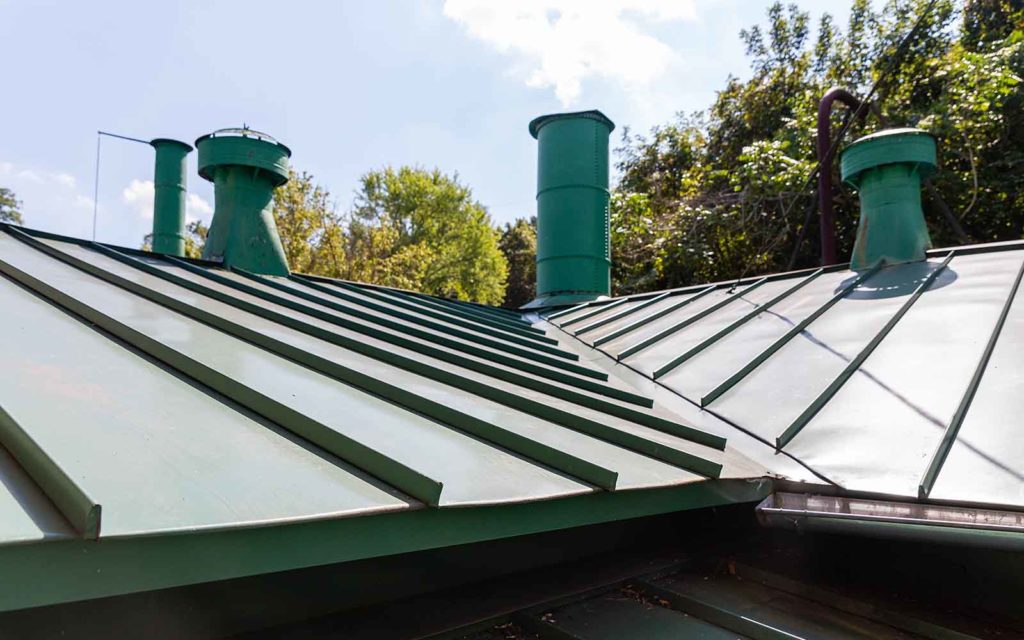
The roof was installed in 2011. Image by Richard Kelly Photography.
Then in June 2012, Rivers of Steel commissioned the architecture and preservation firm of Pfaffman + Associates of Pittsburgh to complete a Conservation Assessment Program Historic Structures Report. The goal was to develop a historic structure report that evaluated the condition and architectural integrity of the building and review existing preservation plans. The subsequent work outlined in this report resulted in a four-phase restoration that addressed the most pressing needs first.
Four Phases of Restoration
By 2014, the first phase of preservation and restoration began, addressing structural issues on the site. A failing wall in the foundry was restructured, as was the catwalk. This phase also addressed critical window repair and some adjustments to the roof. Completed in 2018, phase two focused on repairs of the central light well, including the windows and water drainage in that location. In phase three, the historic preservation focused on repairing the structure’s windows and frames on the back and one side of the building. The six-over-six windows were repaired, retaining the original single-pane, hand-blown glass with a few replacements. The second aspect of phase three was the repair of the original clapboard siding on several of the exterior walls. Phase four, which was just completed in September, saw the repair of the 22 remaining windows, five doors, and the clapboard siding on the front of the building. New red paint was applied to match its historic color, and the exterior letters that spell out “W.A. Young & Son’s Foundry and Machine Shop” were repainted white.
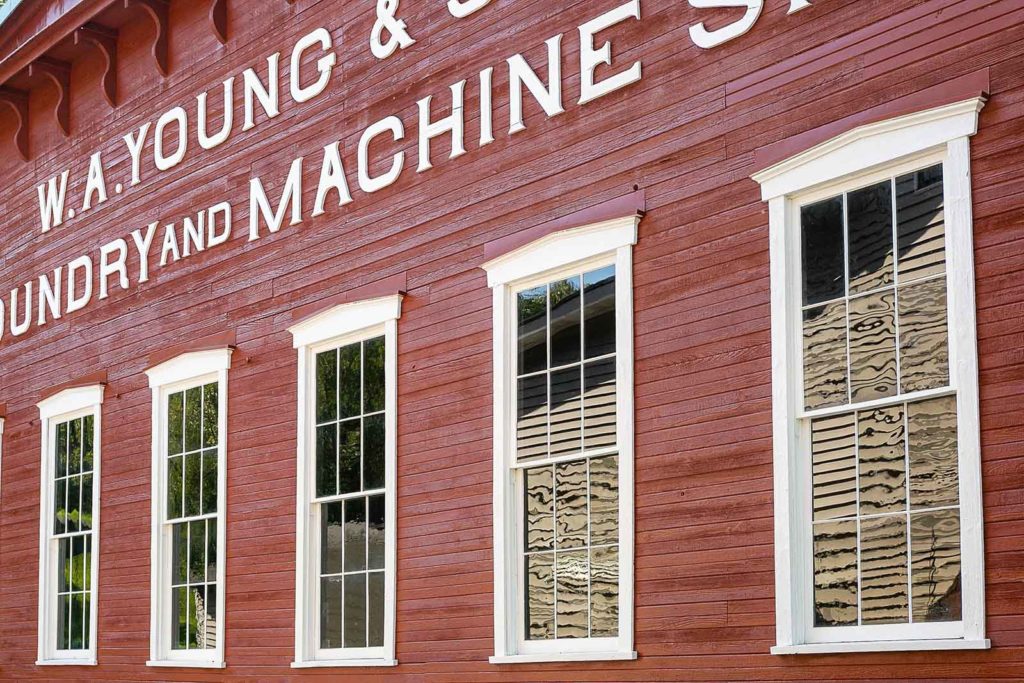
The vinyl siding on a neighboring house is reflected in the hand-blown glass on the newly restored windows of the Machine Shop. Image by Richard Kelly Photography.
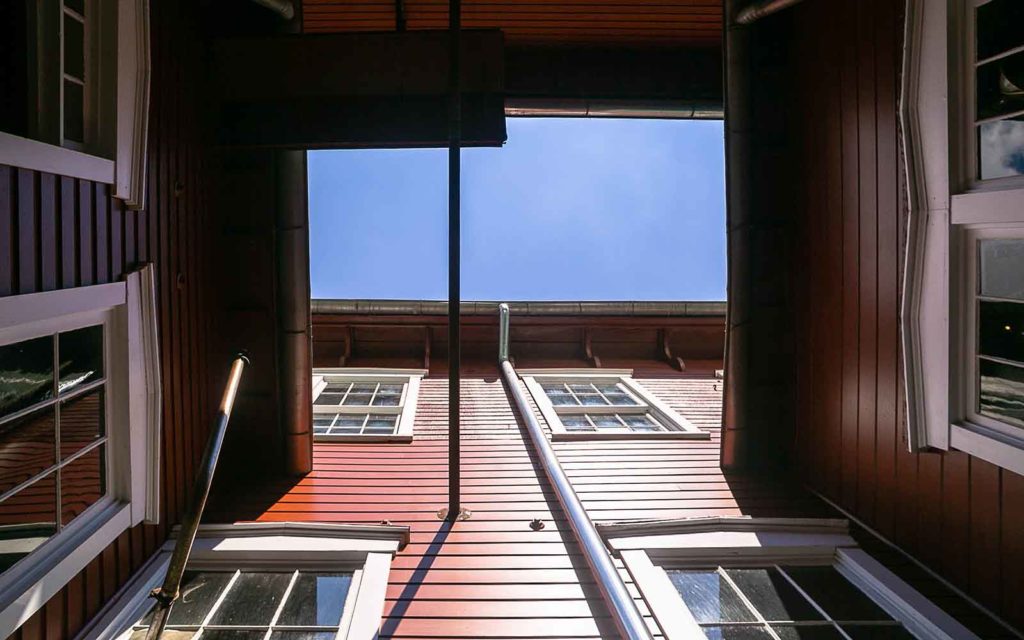
Looking up from the light well that was repaired in phase two of the restoration. Image by Richard Kelly Photography.
Maintaining the Charm & Respecting the History
Throughout the years, Rivers of Steel has also addressed the maintenance of the interior of the shop, replacing floorboards as needed. Work on the machines is ongoing to ensure that those that work remain in good operating order and to bring others back online. Maintenance also includes the repair of the belts for the line shaft system. As Augie said, “We have to be careful to retain the facility’s original charm and respect its history, while ensuring safety for those who visit it.”
For those looking to visit the Machine Shop, guided tours are available on Sundays through November 21. Otherwise, plan to return in the spring for a tour or save the date for the Hammer-In Festival on April 16, 2022.
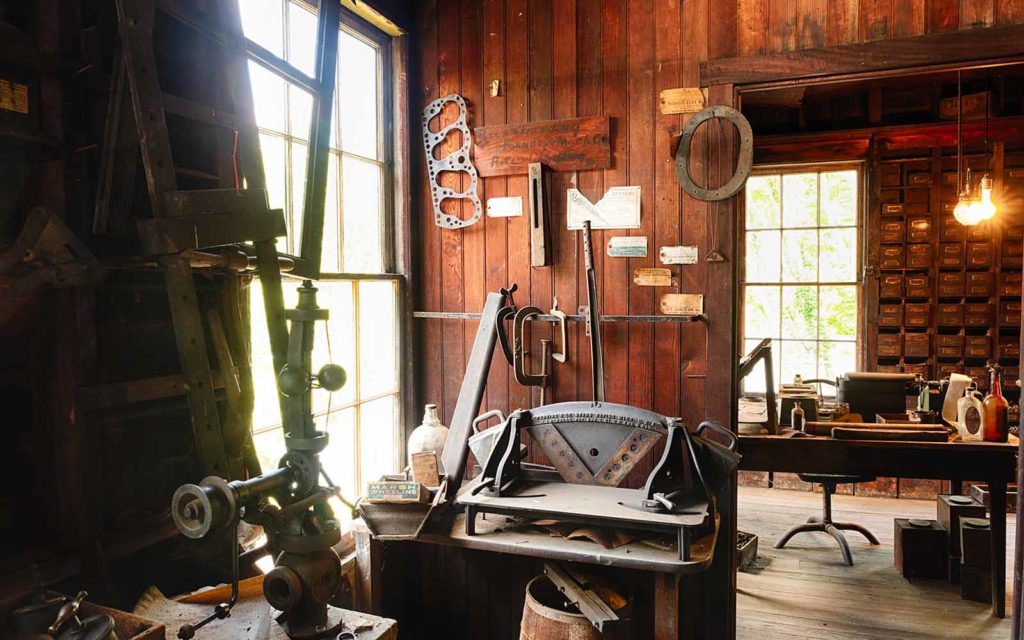
A view from the pattern shop into the hardware store on the upper level showcases the charm of this historic landmark. Image by Richard Kelly Photography.
Support for the Historic Preservation of the Machine Shop
Support for the preservation and restoration of the Machine Shop has been provided by Rivers of Steel and by the National Park Service, the Pennsylvania Department of Conservation and Natural Resources, Save America’s Treasures, the Department of the Interior, the Pennsylvania Historical & Museum Commission, The Allegheny Foundation, and from Visit Greene, the Greene County Tourist Promotion Agency.
Can’t make it for a tour? Watch a recording of a virtual presentation about the Machine Shop from August of 2020. It includes a guided tour of the Machine Shop, along with a discussion by Rivers of Steel staff about the history, preservation, and restoration of this National Historic Landmark.

